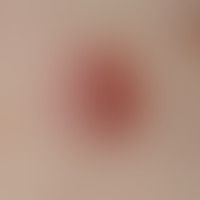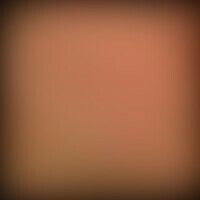
Leprosy reaction A30.8
Leprosy reaction type I: Cell-mediated inflammatory (flare-up) reaction in existing leprosy foci, here lepromatous leprosy.

Rosacea L71.1; L71.8; L71.9;
Rosacea: Rosacea papulopustulosa 2 years after "low dose - isotretinoin therapy" .

Asymmetrical nevus flammeus Q82.5
Naevus flammeus (Port-wine stain): congenitalerythema in the facial region (capillary vascular malformation), localized in V2 distribution, completely without symptoms. 4-month-old boy, developed according to age.

Infant haemangioma (overview) D18.01
Haemangioma of the infant (series: 3-month-old infant); initial findings of a large hemangioma with little elevation.

Basal cell carcinoma (overview) C44.-
Basal cell carcinoma (overview): Nodular basal cell carcinoma with a shiny, smooth surface interspersed with bizarre telangiectases.

Basal cell carcinoma nodular C44.L
Basal cell carcinoma, nodular, centrally ulcerated tumor with a clear wall at the edge of the temporal region. Ulcer not painful. Characteristic for the diagnosis "basal cell carcinoma ulcerated" is the raised, reflecting wall of the "ulcer" with the bizarre vascular structures already visible with the naked eye, which run over the wall (see edge region below right).

Asymmetrical nevus flammeus Q82.5
Naevus flammeus (port wine stain): congenital erythema in the facial region (capillary vascular malformation), localized in V2 distribution, completely without symptoms. 4-month-old boy, developed according to age.

Acne (overview) L70.0
Acne papulopustulosa: disseminated follicular papules, pustules and retracted scars; recurrent course.

Contagious impetigo L01.0

Folliculitis barbae L73.8
Folliculitis barbae: Chronic therapy-resistant, inflammatory follicular papules and pustules in the area of the cheeks; Staphylococcus aureus could be obtained from pustular material several times.

Lupus erythematosus subacute-cutaneous L93.1

Zoster B02.9
zoster. right sided headache with accompanying feeling of illness, increasing for 5 days. redness and swelling of the skin with stabbing, shooting pain for 3 days. extensive erythema and swelling. skin is highly sensitive to touch. no fever. no leukocytosis.

Psoriasis vulgaris L40.00
psoriasis vulgaris. plaque psoriasis. solitary, chronically inpatient, intermittent, sharply delineated, reddish, silvery scaly plaques localized in the face in a 6-year-old girl. erythrosquamous plaques also appear on the extensor sides of the arms and legs. symmetrical infestation. positive family history.

Lupus erythematodes chronicus discoides L93.0
Lupus erythematodes chronicus discoides: persistent, progressive skin changes in a 67-year-old patient for 15 years; large, hyperesthetic, red, centrally ulcerated plaque.

Basal cell carcinoma ulcerated C44.L
Basal cell carcinoma ulcerated: skin change existing for years. Initially symptomless nodule, increasing surface growth, central ulcer formation. Typical for the diagnosis "basal cell carcinoma" is the raised, glassy appearing border wall.

Hydroa vacciniforme L56.8
Hidroa vacciniformia: Occurrence of pinhead-sized, partially umbilical vesicles with serous content in the region of the bridge of the nose in an 8-year-old boy after UV exposure.

Artifacts (overview) L98.1
artifacts: greasy crusty covered flat ulcers. no indication of acne. no indication of other organ diseases







